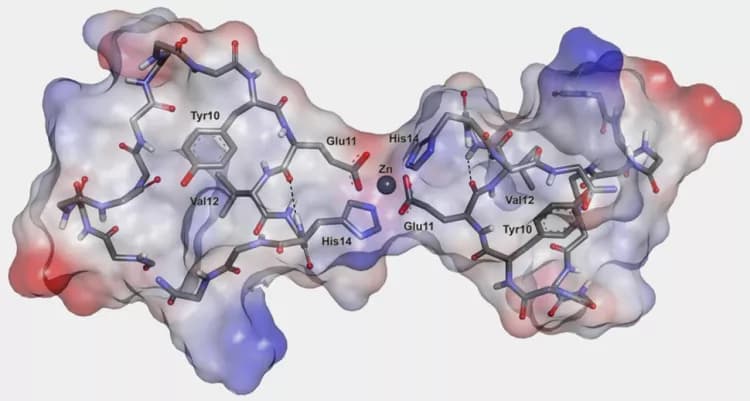
Scientists May Have Found The 'Trigger' Of Alzheimer's Disease
A group of the Lomonosov Moscow State University scientists, together with their colleagues from the Institute of Molecular Biology, Russian Academy of Sciences and the King's College London, succeeded in sorting out the mechanism of Alzheimer's disease development and possibly distinguished its key trigger. Their article was published in Scientific Reports.
'Alzheimer's disease is a widespread degenerative damage of central nervous system leading to a loss of mental ability.'Until now it was considered incurable,' tells Vladimir Polshakov, the leading researcher, MSU Faculty of Fundamental Medicine. Though now scientists managed to distinguish the mechanism 'running' the disease development, so, a chance appeared to elaborate some new chemical compounds, that may work as an efficient cure.
Several hypotheses are dedicated to the Alzheimer's disease development. One of the most common is the so-called amyloid hypothesis.
Amyloids (to be precise, beta-amyloid peptides) are molecular constructions of a protein type and in its normal healthy state they provide a protection to the brain cells. They live fast, and having fulfilled their function they fall prey to the work of proteases, the cleaning enzymes that cut all the used protein elements into harmless 'slags' that are further reclaimed or removed from a body. However, according to the amyloid hypothesis, at some point something goes wrong, and the cells' protectors turn to be their killers. Moreover, those peptides start gathering, forming aggregations and hence getting out of the reach of proteases' cutting blades. Within the amyloid hypothesis this mechanism is more or less precisely described on the later stages of the disease, when the toxic aggregations appeared already and further, when the brain is covered with amyloid plaques. However, the early stage of a beta-amyloid transformation into harmful organic products is highly unexplored.
'We knew, for example, that a crucial role in initiation of such processes is played by ions of several transition metals, first of all -- zinc,' tells Vladimir Polshakov. 'Zinc actually conducts a number of useful and healthy functions in a brain, though in this case it was reasonably suspected as a 'pest', and particularly as an initiator of a cascade of processes, leading to theAlzheimer'sdisease. However, it remained unclear, what exactly happens during an interaction of zin? ions with peptide molecules, which amino acids bind zinc ions, and how such interaction stipulates a peptide aggregation. We set a goal to clarify at least some of those questions'.
Scientists studied various pathogenic beta-amyloid peptides, their so-called metal binding domains -- relatively short peptide regions, capable to bind metal ions. A number of experimental techniques were applied, including nuclear magnetic resonance (NMR) spectroscopy, used to determine the structure of the forming molecular complexes. Some spectra requiring higher sensitivity were additionally measured in London. According to Polshakov, the choice of the studied pathogens was 'partly a luck'. One of the specimens was the product of so-called 'English mutation' -- peptide, different from a common beta-amyloid peptide only with one amino acid substitution. Using the NMR spectroscopy scientists managed to sort out chemical processes and structural changes while a peptide molecules interact with zinc ion and undergo further aggregation.
The second pathogen was an isomerized beta-amyloid peptide. It was not different from a normal one in its chemical composition, though one of its amino acid residues, aspartic acid, was in a form with a specific atomic positioning. Such isomerism happens spontaneously, without help of any enzymes, and is related to the ageing processes, another influential factor of the Alzheimer's disease. Fellow biologists from the Moscow's Institute of Molecular Biology showed recently, that administration of an isomerized peptide to transgenic mice led to an accelerated formation of amyloid plaques. With the presence of zinc ions, a metal binding domain of the isomerized peptide aggregated so fast that the forming structures were hard to detect. Though scientists managed to distinguish that despite all the differences in processes occurring to the 'English mutant' and isomerized peptide in presence of zinc ions, initial stages of these transformations were similar. The trigger happened to be the same -- a role of a pathogenic aggregation's seed was in both cases played by initially formed peptide dimers, i.e. two peptide molecules, connected to each other with help of zinc ion. Such dimers were also detected in normal human peptides, and the difference in all the studied forms could be explained by the speed of formation of corresponding dimer and its proneness to a further aggregation.
Based on their findings, researches proposed the mechanism of zinc-controlled transformation of a peptide-protector into a peptide-killer. That mechanism, scientists notice, explains multiple experimental data, not only gathered by the group, but also collected by their colleagues in other laboratories preoccupied with the Alzheimer's disease studies. Researchers also hope that thanks to a very certain targeting their discovery would help to produce new medicine capable to block beta-amyloid peptide aggregation stipulated by zinc ions.
The above post is reprinted from materials provided by Lomonosov Moscow State University. Note: Materials may be edited for content and length.
Disclaimer: DoveMed is not responsible for the adapted accuracy of news releases posted to DoveMed by contributing universities and institutions.
Primary Resource:
Istrate, A. N., Kozin, S. A., Zhokhov, S. S., Mantsyzov, A. B., Kechko, O. I., Pastore, A., ... & Polshakov, V. I. (2016). Interplay of histidine residues of the Alzheimer’s disease Aβ peptide governs its Zn-induced oligomerization.Scientific reports, 6.
Related Articles
Test Your Knowledge
Asked by users
Related Centers
Related Specialties
Related Physicians
Related Procedures
Related Resources
Join DoveHubs
and connect with fellow professionals

0 Comments
Please log in to post a comment.